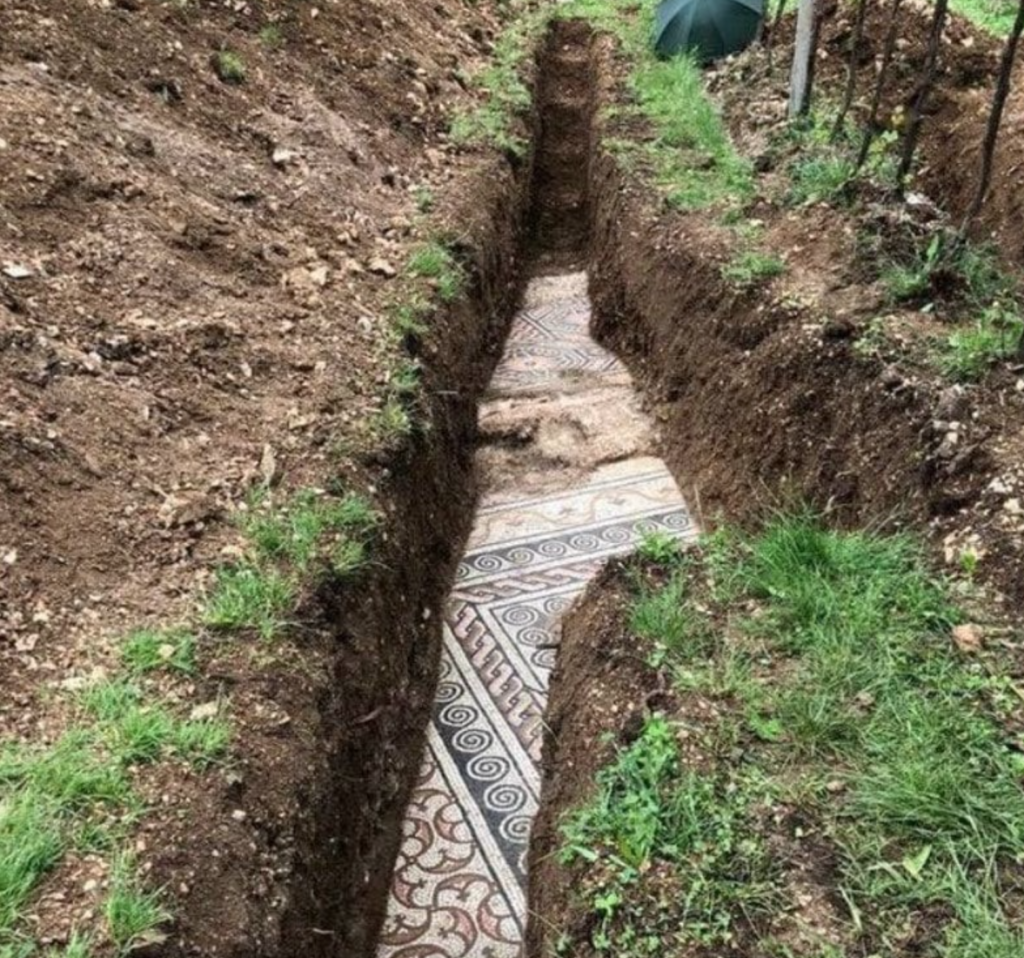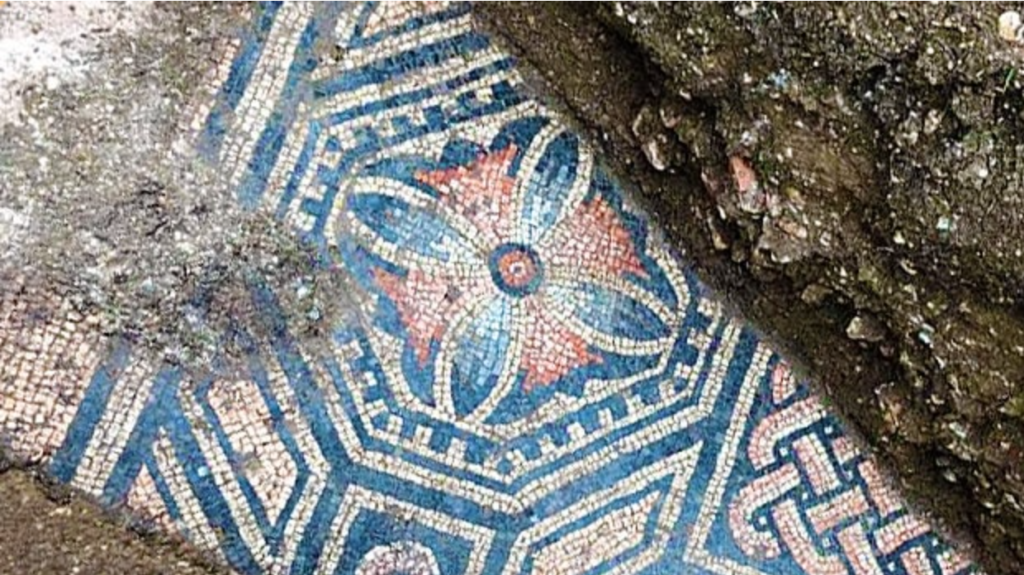The stunning discovery of a third-century Roman mosaic beneath a vineyard in Verona, Italy, has reignited global interest in ancient Roman history and artistry. This breathtaking find, hidden beneath the earth for over a century, showcases the Romans’ ingenuity, craftsmanship, and timeless cultural legacy.
The mosaic’s intricate patterns and impeccable preservation are not just a marvel of the past but also a gateway to understanding the lives of the Romans who once called this region home.

The Story Behind the Discovery
For decades, archaeologists had been tantalized by hints of a hidden Roman villa buried in the hills of Negrar di Valpolicella, near Verona. The first evidence of the site appeared in the early 1900s when researchers identified remnants of ancient structures beneath local farmland. Despite numerous efforts, the search for the villa’s treasures remained elusive.
Finally, after years of excavation, a team led by the Verona Superintendent of Archaeology, Fine Arts, and Landscape uncovered the long-hidden gem: an exquisite Roman mosaic floor buried beneath a vineyard. The find, announced to the public in 2020, marks one of the most significant archaeological discoveries in recent Italian history.
The farmers who cultivated the land above the mosaic had unknowingly been walking on history for generations. Little did they know that a masterpiece of Roman artistry lay just beneath their feet.
A Masterpiece of Roman Craftsmanship
The Roman mosaic, dating back to the third century AD, is a testament to the artistry and precision of ancient Roman builders. Composed of tesserae—small, colorful tiles made of marble, glass, and stone—the floor features intricate geometric patterns and symmetrical designs.
Each tessera was meticulously laid by skilled artisans, showcasing the Romans’ attention to detail and their ability to combine functionality with aesthetic beauty. The vibrant colors and complex shapes reflect a culture that valued art and craftsmanship as central to their daily lives.
What makes the discovery even more extraordinary is the floor’s remarkable state of preservation. Beneath layers of soil and time, the mosaic remained almost untouched. Experts believe the multiple layers of mortar beneath the tiles suggest the floor underwent periodic repairs, indicating its importance to the villa’s inhabitants.
Unraveling the History of the Roman Villa
The discovery of the mosaic offers a tantalizing glimpse into the lives of the ancient Romans who lived in this region of Italy. The villa, believed to have been a luxurious countryside estate, likely belonged to a wealthy Roman family. Villas such as this served as retreats for Rome’s elite, offering a serene escape from bustling urban life.
Archaeologists believe that the villa may have been a center of both leisure and agriculture. Its proximity to modern vineyards suggests that wine production—a cornerstone of Roman culture—could have been one of its primary activities.
Through careful excavation, experts hope to uncover additional rooms, artifacts, and structural remains that will provide insights into:
- The villa’s layout and architecture.
- The lifestyle of its inhabitants.
- The villa’s economic and cultural role within the Roman Empire.
By piecing together these clues, historians can gain a better understanding of daily life, traditions, and artistic practices during the Roman period.

The Role of Verona in Ancient Roman History
Verona, a city celebrated for its rich history and architectural marvels, was a vital hub during the Roman Empire. Known as Verona Augusta, the city boasted impressive structures like the Arena di Verona, a grand amphitheater that still stands today.
The newly discovered mosaic highlights Verona’s continued significance as a center of Roman art and culture. Villas and estates such as the one in Negrar di Valpolicella demonstrate how Roman influence extended into the countryside, blending urban sophistication with rural tranquility.
This mosaic serves as a tangible link to Verona’s illustrious past, adding to its already impressive historical tapestry.
Preserving the Mosaic for Future Generations
With the mosaic now uncovered, the challenge lies in ensuring its preservation while making it accessible to the public. Ancient mosaics are delicate artifacts that can easily deteriorate when exposed to light, moisture, and environmental factors.
The Verona Superintendent of Archaeology is working closely with local authorities, historians, and preservationists to determine the best course of action. Potential solutions include:
- Covering the mosaic with protective materials to shield it from the elements.
- Creating a controlled exhibition space where visitors can view the mosaic while ensuring its long-term safety.
- Incorporating advanced technology such as 3D scanning to create virtual models of the floor for educational purposes.
The ultimate goal is to strike a balance between public access and historical preservation, allowing future generations to admire this extraordinary piece of Roman heritage.
A Symbol of Perseverance and Cultural Fascination
The discovery of the Roman mosaic in Verona is more than just an archaeological triumph—it is a symbol of human perseverance and our enduring fascination with the ancient world. For over a century, archaeologists remained committed to uncovering this lost treasure, and their dedication has been richly rewarded.
The mosaic also reminds us of the Romans’ profound legacy. Their innovations in architecture, art, and engineering continue to captivate and inspire people worldwide. Every tile of the mosaic tells a story—a story of craftsmanship, culture, and the timeless pursuit of beauty.
Conclusion: A Treasure Unearthed, A Legacy Preserved
The unearthing of the Roman mosaic beneath a vineyard in Verona, Italy, stands as a breathtaking reminder of our shared history. Hidden for centuries, this intricate masterpiece reflects the artistic brilliance of the Roman Empire and provides a window into the lives of those who came before us.
As preservation efforts move forward, this discovery will undoubtedly become a source of pride for Verona and a destination for history enthusiasts worldwide. Whether viewed in person or through virtual recreations, the mosaic serves as a timeless tribute to human creativity and resilience.
From the skilled artisans who crafted it to the modern-day archaeologists who unearthed it, this Roman mosaic is more than a relic of the past—it is a celebration of our connection to history, art, and the enduring pursuit of discovery.